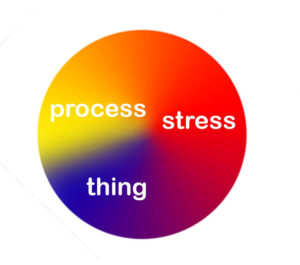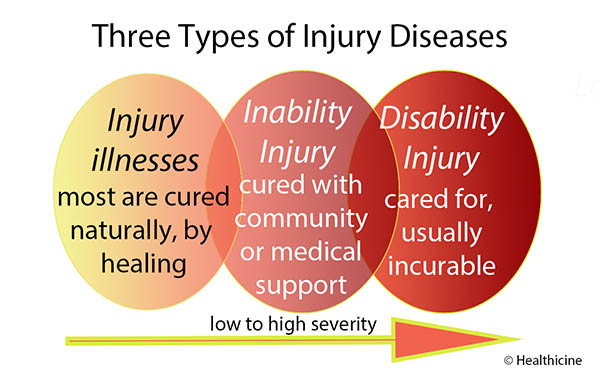In Part 1, of this series, we explored the healthiness of disease at levels of species and community. Each species, and each community within a species, needs to cooperate and compete with other species and other communities. Competition expands abilities of individuals and of the species. Individuals compete to expand their boundaries, but this can lead to disease in individuals.
A certain level of disease in individuals is essential for the health of communities and the species.
In this section we look at injury diseases. We might not think of injuries as diseases – but the World Health Organization’s International Classification of Diseases (WHO/ICD) clearly recognizes injury diseases and has many injury disease codes. In addition, injuries are often caused by illness.
Many diseases cannot be diagnosed until injuries are present.
Three Basic Causes of Illness.
An element of illness has a single cause, an element of cause. Is every cause of illness bad? Are any causes of illness bad all of the time?
There are three elementary causes of illness, as illustrated in this circle. Causes of illness can be nouns, or attributes – like bacteria or poisons; they can be processes – like poor diet; or they can be stresses – like falling.
Injuries are caused by force or stress. An injury can occur to the body, the mind, the spirits, even the community of a patient, caused by an excess of stress on body, mind, spirits, or communities.
Benjaman Rush said, “There is a grade of benevolence in our profession much higher than that which arises from the cure of diseases. It exists in exterminating their causes.”
Benjaman Rush got it wrong. In a medical view that might seem logical to prevent all causes of disease. Working to “exterminate causes” of disease is a failure to understand the healthiness of cause. Most causes of illness are healthy, not negative until they cause illness. Causes are like dandelions – harmful in one situation – but can be healthicines, even medicines in other situations.
A negative process, attribute, even injury, that produces illness can be positive and healthy in different circumstances. In addition, many illnesses provide both positive and negative consequences. Life, health, illness, diseases, and cures are not binary, not trivial.
We judge an illness or disease to be negative. Therefore, we judge a cause to be negative when we identify it as a cause of a specific case of illness. We can judge the same cause to be positive when we identify it as a cause of healthiness or a cure. Water causes healthiness. Too much water causes disease. The cause is not about the water, it’s about the individual and their current status.
Let’s begin with something so simple we hardly think of it as a disease: injuries.
What is the Purpose of an Injury?
Imagine a world with no injuries? What would it be like if we prevent all injuries?Remember when we were children? Without injuries, there would be no “he pinched me,” no scratches and bruises, no nosebleeds, no broken bones. No one would fall and scrape their knee or fall off their bike and bump their head. There would be no bullies, not physical, not mental, not spiritual, because no bully could cause any injury. Would the world be a better place? Would children learn to run, to ride, and to fight back? Would they learn to challenge themselves and others, to attain higher and higher goals? No. When we extend this concept to adults, the consequences are catastrophic.
Without injuries – there would be no champions, no local champions, city champions, state champions, national champions, and Olympic champions in any sport. The risks of injury would be too great. Hmm… is this beginning to sound a bit like a COVID-19 pandemic.
Champions become champions by challenging individual physical, mental, spirit, and community boundaries. Sometimes, they are injured. Every champion sustains injuries on the way to the top. Some die in training or competition. But without risk of injury – there are no champions.
Many diseases are essential to life and to the health of the species. Dead things don’t get diseases. They can’t be injured. They don’t get ahead either. The stone at the top of the hill is no better off than one at the bottom. A human might advance by successfully climbing a mountain, or by descending into a valley. Our spirits, our intentions define life, health, and success. Life progresses by overcoming boundaries, not by avoiding them.
Of course, we need to avoid injury diseases. We need to enable healthy actions and healthy lives. We also need to recognize that avoiding all risk of injury is not a healthy goal. Living entities are constantly injuring and healing. Minor injuries are essential to health. Without injuries, there would be no healing. Healing is essential to health. What doesn’t kill us, as individuals, truly can make us, and our species, stronger.
Injuries define an individual’s healthy life boundaries. When we cross a boundary – we might be injured. There are three degrees of injury diseases, based on treatment and cure.
Healing is a form of cure. All life forms have some ability to heal, to recover from injuries. Healing often makes us stronger, or more confident, able to get back on that bike, horse, or other challenge.
Humans take health and healing cures to much higher levels. Our bodies have many healing processes, but we add powerful forces of community to aid healing cures. We study healthiness and nutrition to foster healing. We develop treatments and technologies to promote healing cures. When we can’t cure an injury, we provide care and support to the disabled individual.
We have life boundaries in diet, body, mind, spirits, communities, and environment. Life boundaries are present in our needs (deficiencies) and our poisons (excesses). We have boundaries in exercise and rest. Too little or too much can cause an injury illness. Boundaries vary depending on the individual, their strengths, their weaknesses, their goals. They change as our life changes. A healthy training exercise for an Olympic competitor might break the leg of a normal person.
When we think about our injuries, or about the risk of injuries, we often find a way to accomplish our goals with less risk of injury. But some injuries are essential to success. We learn and gain as much from our failures as from our success.
What if there were no injury diseases? Would we be better off? No. We would be the worse for it. Injuries are an essential part of healthiness.
This post is part 2 of the chapter: On the Healthiness of Disease in the book: COVID-19 from Causes to Cures. In the next post, I will discuss the healthiness of Non-infectious Diseases.
to your health, tracy
Author: The Elements of Cure




